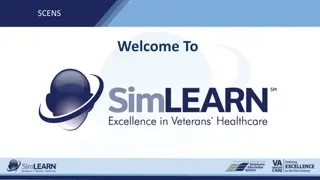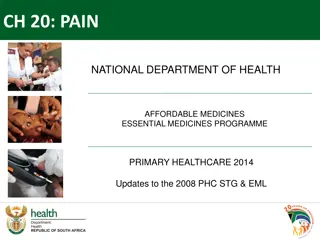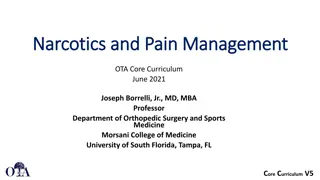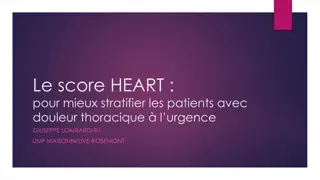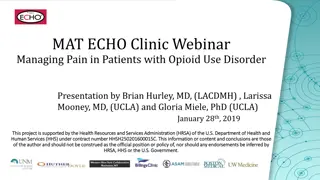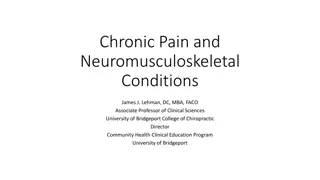Chest Imaging Interpretation for Tuberculosis Screening
Chest imaging plays a crucial role in screening for pulmonary tuberculosis (TB). This activity, led by Dana Kissner from Wayne State University Detroit Tuberculosis Clinic, focuses on interpreting chest imaging results to aid in the diagnosis and management of TB cases. The content includes informat
3 views • 22 slides
Interpersonal factors and their impact on pain transitions
Exploring the impact of interpersonal factors on pain transitions, this research delves into the communication and behaviors between individuals experiencing pain, such as parent-child relationships and interactions with healthcare providers. The study analyzes psychosocial mechanisms influencing pa
3 views • 24 slides
Acute orofacial pain
Acute orofacial pain is often associated with dental issues, ranging from dentinal pain to periodontal pain. The pain can be moderate to severe, with various triggers such as mechanical stimulation and changes in osmotic pressure. This pain is prevalent in adults and can spread to different areas of
1 views • 49 slides
Understanding Breast Pain and the Breast Pain Pathway
Breast pain, characterized by tenderness, throbbing, sharp, or burning sensations in the breast tissue, can affect individuals of all genders. This common symptom may vary in severity and frequency, and is typically not associated with cancer. The Breast Pain Pathway outlines the management of breas
2 views • 13 slides
Understanding Sickle Cell Disease Pain Management
Sickle cell disease (SCD) patients often experience vaso-occlusive crises (VOC) causing acute pain, a hallmark symptom of the disease. Pain management is crucial in healthcare interactions for these patients, with chronic pain also being a significant concern due to organ/tissue damage. Research sho
1 views • 18 slides
Common Role of Pain Management for Chronic Back Pain
Discover how CT Clinic Presents is revolutionizing the approach to chronic back pain treatment through a comprehensive Pain Management program. We prioritize patient education, offering insights into the condition and its management. Our holistic approach integrates medication management, physiother
1 views • 1 slides
Managing Acute Chest Syndrome in Sickle Cell Disease
A case study of a 31-year-old male with sickle cell disease presenting in the emergency department with a pain crisis. The patient has a history of avascular necrosis, priapism, NSTEMI, cholecystectomy, and previous acute chest syndrome. Explore the patient's symptoms, past medical history, and reco
7 views • 19 slides
Assessment and Diagnostic Tests in Musculoskeletal System Pain
Pain in musculoskeletal conditions varies, such as bone pain described as dull and deep, muscular pain as soreness, fracture pain as sharp, and joint pain worsens with movement. Specific assessments by nurses include checking body alignment, joint symmetry, signs of inflammation, pressure sources, a
7 views • 38 slides
Do you want relief from Neck Pain in South Brisbane
Do you want relief from Neck Pain in South Brisbane? Then contact Innervate Chiro. Their dedicated practitioners combine their experience in Chiropractic, Remedial & Sports Massage for fast effective relief of Back Pain, Neck Pain, Headaches, Vertigo, Sports Injuries, shoulder, hip, nerve pain, scia
0 views • 6 slides
Get the best physiotherapy for Back Pain in Orchard
Get the best physiotherapy for Back Pain in Orchard at Physiolife Pte Ltd. Their experienced therapists provide hands-on therapy and evidence-based practice to individuals seeking personalized treatment for their pain and injuries. They specialize in technology-powered solutions like medical massage
2 views • 6 slides
Clinical Protocols for Chest Pain Management
This presentation covers key aspects of managing chest pain cases, including focused assessments, implementing protocols, responding to cardiac arrest, and facilitating effective communication. It discusses the importance of VHA Directive 1177 and various guidelines to improve patient outcomes in ac
0 views • 12 slides
Complex Case Study: Chronic Pain and Somatic Symptom Disorder
Michelle Adams, a 51-year-old hairdresser, presents with severe chronic back pain following a traumatic incident. Despite various treatments and medications, her pain persists, leading to distress and functional impairment. Her symptoms align with Somatic Symptom Disorder (SSD) with predominant pain
0 views • 50 slides
Understanding Opioid and Non-Opioid Analgesics in Pain Management
Opioid analgesics, such as morphine, act in the central nervous system to relieve pain without affecting consciousness. They differ from non-opioid analgesics like aspirin in terms of CNS depression, pain type targeted, and addiction potential. Pain is a protective mechanism caused by tissue damage
0 views • 25 slides
Understanding Central Abdominal Pain and Masses in Clinical Practice
Abdominal pain evaluation involves considering various differential diagnoses such as appendicitis, small bowel obstruction, and mesenteric ischemia. By categorizing pain as visceral, parietal, referred, or radiating, healthcare providers can better understand the underlying pathology. The history o
0 views • 57 slides
Understanding the Gate Control Theory of Pain in Pain Management
This detailed content delves into the Gate Control Theory of Pain, explaining pain pathways involving nociceptors, A-delta fibers, and C fibers. It further explores central pain pathways like the spinothalamic tract, spinomesencephalic tract, and spinoreticular tract. The theory's mechanism of pain
3 views • 11 slides
Endovascular Stenting for Superior Vena Cava Occlusion: A Case Study
Superior Vena Cava (SVC) occlusion secondary to postradiation fibrosis is a rare condition that can lead to debilitating symptoms. In this case study, a 47-year-old male with a history of Hodgkin lymphoma treated with chest radiotherapy presented with exertional chest pain and other associated sympt
1 views • 19 slides
Common Night Float Calls in Internal Medicine: An Overview
Night float responsibilities for Internal Medicine Chief Residents involve responding to all medical team patient pages, documenting calls, and participating in emergent situations like code blues and stroke teams. Specific scenarios like chest pain and abdominal pain require prompt assessment and d
0 views • 32 slides
Update on Pain Management in Primary Healthcare
The updates to the 2014 Primary Healthcare Implementation Slides focus on pain control for children, including the addition of ibuprofen and exclusion of tramadol for moderate pain. The management of acute severe pain involves retaining morphine injection while omitting metocloperamide, paracetamol,
0 views • 10 slides
Understanding Pediatric Pain Management
Explore the complexities of managing pain in infants and children, including defining pain, classifying different types of pain, understanding pain assessment tools, identifying medication classes for treatment, and recognizing special considerations. Discover insights on acute and chronic pain, neu
1 views • 40 slides
Understanding the Brain: Key Insights on Chronic Pain and EMDR Therapy
Persistent pain is often a symptom originating from the brain, not the body tissues. EMDR therapy can help reprocess maladaptive memory networks linked to chronic pain, addressing root causes including adverse childhood experiences. The AIP model emphasizes early-life factors in shaping chronic pain
0 views • 28 slides
Understanding Chest Pain Management at Primary Healthcare Level
Chest pain is a common presentation requiring swift identification and management to distinguish life-threatening causes like Myocardial Infarction. This article focuses on the approach to chest pain at a primary healthcare level, detailing cardiac and non-cardiac causes, recognizing urgent cases, a
2 views • 52 slides
Understanding Pain Assessment: Factors, Tools, and Relief
Pain assessment is crucial for understanding and managing patients' pain perception. This involves identifying different forms of pain, factors affecting pain sensitivity, behavioral responses to pain, and utilizing pain assessment tools for accurate evaluation. Factors influencing pain sensitivity
0 views • 18 slides
Understanding Pain: Mechanisms and Pathways
This content delves into the intricate mechanisms of pain perception, exploring the anterolateral system, nociceptors, endogenous analgesic systems, and more. It covers topics such as free nerve endings, VR1/Capsaicin receptors, referred pain, neuropathic pain, hyperalgesia, and visceral pain. The m
0 views • 15 slides
Integrative Approaches to Pediatric Pain Management: A Comprehensive Review
Pediatric pain management is a complex issue involving factors such as inflammation, neuroplasticity, and emotional responses. Dr. Matthew Hand explores integrative approaches to address common pediatric pain conditions and highlights the prevalence of chronic pain in children. The presentation delv
0 views • 39 slides
Understanding Pain Management in Orthopedic Surgery
Pain management in orthopedic surgery involves reviewing pain pathways, mitigating pain transmission, understanding pain medications, and implementing multi-modal pain relief strategies. Pain is a complex and subjective experience with sensory, affective, emotional, and cognitive dimensions. Factors
0 views • 51 slides
Case Presentation: Kartagener Syndrome in a 24-Year-Old Male
24-year-old male patient with a history of asthma and bronchiectasis presents with worsening shortness of breath and chest pain. Neonatal history reveals Situs inversus and dextrocardia, recurrent upper and lower respiratory tract infections, while childhood history includes asthma diagnosis and chr
0 views • 24 slides
Recognizing Serious Symptoms During Pregnancy
Learn about the symptoms that are considered normal during pregnancy and when you should be alarmed, such as chest pain, severe chest or back pain, breathlessness, anxiety, and palpitations. This guide highlights specific scenarios and risk factors that require urgent medical attention to ensure the
0 views • 18 slides
Understanding Postoperative Pain Measurement Methods
Standard methods for measuring postoperative pain include categorical, visual analogue, and numerical rating scales. Patients should self-assess their pain using these tools for accurate reporting, as demonstrated by research on pain congruence between patients and nurses. Enhancing understanding of
0 views • 16 slides
Management of Pneumothorax in Adult Males: Clinical Scenarios and Recommendations
In this medical case study, two scenarios of adult males presenting with pleuritic chest pain and pneumothorax are discussed. The first scenario involves a 25-year-old with sudden onset chest pain, while the second scenario involves a 60-year-old with COPD. Recommendations for managing pneumothorax,
0 views • 26 slides
Understanding Non-Opioid Pain Management Strategies
Non-opioid pain management is crucial in the current opioid epidemic, requiring physicians to navigate chronic pain without relying on opioids. This comprehensive approach involves a deep understanding of non-opioid analgesic medications, the nature of pain, anatomy, and physiology of nociception, t
0 views • 36 slides
Understanding Pain Management: Acute vs. Chronic Pain and Interventional Therapies
Pain is a complex experience that can be acute or chronic, requiring different treatment approaches. Acute pain alerts us to potential injury, while chronic pain lasts longer and affects quality of life. Management options range from medical and psychological treatments to advanced interventions and
0 views • 26 slides
Heart Score for Improved Risk Stratification in Patients with Chest Pain
Heart Score is a valuable tool for stratifying patients with chest pain in the emergency setting, aiding in clinical decision-making. This algorithm helps differentiate causes of thoracic pain effectively, minimizing false negatives and reducing unnecessary hospital admissions. By assessing factors
0 views • 30 slides
Cost Savings in Postoperative Pain Management with NOL-Guided Anesthesia
Acute postoperative pain is a significant issue globally, with high prevalence rates and potential long-term consequences. This economic assessment explores cost savings associated with using NOL-guided anesthesia to optimize postoperative pain treatment. By categorizing postoperative pain scores an
0 views • 4 slides
Understanding Chronic Pain, Opioids, and Addiction in Medicine
Chronic pain is a complex issue that can impact individuals on various levels. It is important to understand the subjective nature of pain and the barriers to adequate pain care. Opioid analgesics, while effective in managing pain, come with risks such as side effects, addiction, and overdose potent
0 views • 28 slides
Managing Pain in Patients with Opioid Use Disorder: Strategies and Approaches
This presentation discusses essential factors to consider when treating pain in patients with Substance Use Disorder (SUD), including approaches for acute pain in those on Medication-Assisted Treatment (MAT) and non-opioid therapies for chronic pain. The information covers altered pain experiences i
0 views • 26 slides
Clinical Cases and Diagnostic Imaging Analysis in Emergency Medicine
This content delves into multiple clinical cases captured through diagnostic imaging, highlighting the patient presentations, radiological findings, potential diagnoses, and recommended treatments. The cases cover scenarios such as shoulder injuries, chest pain with associated symptoms, hip pain in
0 views • 19 slides
Understanding the HEART Score for Risk Stratification in Patients with Chest Pain
The HEART score is a valuable tool for stratifying patients presenting with chest pain in the emergency department. It helps in distinguishing between low, intermediate, and high-risk individuals and guides further management decisions. By incorporating factors like history, ECG findings, age, risk
0 views • 30 slides
Understanding Chronic Pain: A Comprehensive Overview
Chronic pain and neuromusculoskeletal conditions are prevalent health issues that require a specialized approach for accurate diagnosis and treatment. This content delves into learning objectives, national pain strategies, and the significance of addressing persistent pain as a chronic illness that
0 views • 80 slides
Comprehensive Overview of Pharmacological Pain Management Strategies
This comprehensive overview covers various aspects of pharmacological pain management, including behavioral measures for patients unable to self-report pain, building pain regimens, NSAIDs use and associated risks, NSAIDs and COX selectivity, clinical presentation of pain symptoms, gabapentinoids fo
0 views • 22 slides
Clinical Effectiveness of Video Visits for Common Acute Chief Complaints in Primary Care
The study evaluated the clinical effectiveness of video visits for common acute chief complaints in primary care during the COVID-19 pandemic. It found that headache, joint pain, and low back pain cases can be effectively evaluated via video visits, while chest pain and dizziness may require in-pers
1 views • 5 slides










